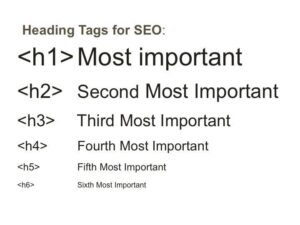Don’t worry! Here are some most important tips that will help you to achieve a higher rank for your website through SEO-friendly website design.
It is very well known that having a professional-looking, well-designed website is not sufficient to make an influential online presence. Your business can reach a broader audience only if your website is in the top results of the search engines when people search for products & services that you offer. This can be achieved with the help of search engine optimization. SEO-friendly web design is an integral part of the SEO process.
Here are some best techniques that will make your website SEO friendly.
High-Quality Content:
Website content is the key element in building successful web design. Consumable content can engage users and increase the engagement ratio. Before actually starting to write content you must do keyword research, monitor social media, and analyze your customer’s needs. While writing web content use keywords wisely; if you stuff keywords then it will create a negative impact on users as well as on your website rank.
Users will be attracted to unique and customer-centric content. High-quality content will increase the time spent by users on your website & help to reduce the bounce rate. The time spent by users on your website that is average session duration is the prime factor in getting a higher website rank.
Titles & Meta Descriptions:
Optimizing title & meta description is very important aspect in making your website SEO friendly. Title and meta descriptions are considered as the most important on-page elements that should be written by following some rules.
- Title should not exceed 70 characters (with spaces). You should include your target keywords in the title.
Here is one sample title format that you can use to construct a unique title
Primary Keyword – Secondary Keyword | Your Brand Name
- Description should be up to 160 characters. It should be keyword-rich and user-appealing. The description should be relevant to the page content as the search engine will ignore the descriptions if it is irrelevant.
So it is important to include focus keywords of respective pages in the description to make them in line with the content. It should be actionable as this is a piece of information that will make users click on your link. You can include a call to action to make it more attractive.
Heading Tags:
Headers are helpful for the separation of contents. Every separate part of the content should be specified with a relevant heading. Heading not only makes it easy to scan content but also gives more weight to it than other content. So it is important to have your keywords in heading tags.
Different headings have different values in search engines. You can use headings from H1 to H6 where H1 is most important & H6 is least important.

Heading should be according to the content mentioned under that heading so that people will get a clear idea about what information you are offering. As search engine gives more weightage to the headings, you must try to use your focus keywords in heading tags. Having optimized heading tags will increase your on-page SEO score.
Image Optimization:
Having images on the website makes it simple to understand, clarifies your offerings, and grabs the attention of users.
Visuals are 70% more consumable than other text content.
But these images should be optimized, they need to be compressed as much as possible without losing their quality. Compressed images load faster and reduce the loading time of the site.
Another important factor in image optimization is alt tags. You should specify something about the image in alt tags that will be displayed in the browser that is unable to display the image. The search engine includes alt tags as a ranking factor so you should specify it correctly.
Don’t forget to check for any broken images on the website. This will not directly affect your search engine rank but can increase bounce rate as users will navigate away from your site because of broken images.
Responsive Design:
The use of mobile phones and tablets for online search is increasing rapidly. Almost 50% of traffic comes from mobile devices. So your website should be mobile friendly to satisfy customers accessing your site from mobile phones and tablets. By making your website responsive, you don’t need to create different versions of your site.
Mobile responsive designs load faster so it gives a better user experience. You need to keep your navigation user-friendly so that every page should be accessed easily. Since users can access images and videos from the websites through mobile, social sharing will be increased. By making your website design responsive, you will get a higher website rank as search engines love responsive designs.
SEO friendly URL structure:
URL is another ranking factor of search engines that you need to consider. URL should direct users to the page they are looking for. It is a good practice to insert relevant terms about the page in the URL but you need to follow some rules to make them right.
- Keep URL length short without losing its meaning
Don’t make subfolders too deep – Avoid deep links
- Avoid dynamic URL structure ( As numbers are confusing, not descriptive )
- URL structure should be based on-site hierarchy
- In case of separating words use hyphens instead of other symbols
For Example http://www.brandname.com/catergory/sub-category
Optimizing URL structure can be an effective strategy to get better SEO results.
Site Speed:
As per Google’s algorithm update, site speed is a ranking factor. You should minimize the site loading time and make it as fast as possible.
40 % of visitors leave the page if it takes more than 3 sec. to load. So by reducing site loading speed, you will experience a higher conversion rate.
For making site faster, there are many factors that you should work on such as:
- Image Compression (Without Losing Quality)
- Avoid Unnecessary redirects
- Optimize Browser Caching
- Minify JavaScript & CSS
- Use Content Delivery Network (CDN)
There are so many other techniques for reducing page speed but by making use of the above technique you will be able to minimize site loading speed to a considerable extent.
Social Media Integration:
Social media platforms allow you to spread your content across the web. The more you share the more you get viewed. Ultimately it increases traffic and leads. If you share social links on the website then the users can access your social accounts and can communicate or interact easily.
Also, you can make your content sharable by implementing social media buttons in your design. Encouraging users and making it easy to share content drives relevant traffic to the website.
Now that you know all the important points that need to be considered while making SEO-friendly web design, it’s time to implement them for your website. SEO-friendly web design increases the chances of getting higher results on search engine result pages.
At IP Websoft, we are offering result-driven SEO services in India as well as overseas. We have delivered many SEO-optimized websites for getting more targeted organic traffic and helped our clients to grow their business.


























